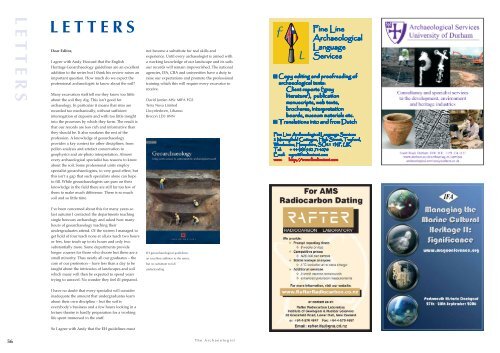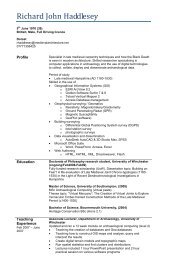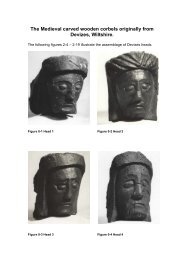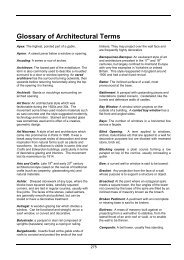The ARCHAEOLOGIST - English Late-Medieval timber-framed ...
The ARCHAEOLOGIST - English Late-Medieval timber-framed ...
The ARCHAEOLOGIST - English Late-Medieval timber-framed ...
You also want an ePaper? Increase the reach of your titles
YUMPU automatically turns print PDFs into web optimized ePapers that Google loves.
LETTERS<br />
LETTERS<br />
Dear Editor,<br />
I agree with Andy Howard that the <strong>English</strong><br />
Heritage Geoarchaeology guidelines are an excellent<br />
addition to the series but I think his review raises an<br />
important question. How much do we expect the<br />
professional archaeologist to know about the soil<br />
Many excavation staff tell me they know too little<br />
about the soil they dig. This isn’t good for<br />
archaeology. In particular it means that sites are<br />
recorded too mechanically, without sufficient<br />
interrogation of deposits and with too little insight<br />
into the processes by which they form. <strong>The</strong> result is<br />
that our records are less rich and informative than<br />
they should be. It also weakens the rest of the<br />
profession. A knowledge of geoarchaeology<br />
provides a key context for other disciplines, from<br />
pollen analysis and artefact conservation to<br />
geophysics and air-photo interpretation. Almost<br />
every archaeological specialist has reasons to know<br />
about the soil. Some professional units employ<br />
specialist geoarchaeologists, to very good effect, but<br />
this isn’t a gap that such specialists alone can hope<br />
to fill. While geoarchaeologists can pass on their<br />
knowledge in the field there are still far too few of<br />
them to make much difference. <strong>The</strong>re is so much<br />
soil and so little time.<br />
not become a substitute for real skills and<br />
experience. Until every archaeologist is armed with<br />
a working knowledge of our landscape and its soils<br />
our records will remain impoverished. <strong>The</strong> national<br />
agencies, IFA, CBA and universities have a duty to<br />
raise our expectations and promote the professional<br />
training which this will require every excavator to<br />
receive.<br />
David Jordan MSc MIFA FGS<br />
Terra Nova Limited<br />
Llwynfedwen, Libanus<br />
Brecon LD3 8NN<br />
I’ve been concerned about this for many years so<br />
last autumn I contacted the departments teaching<br />
single honours archaeology and asked how many<br />
hours of geoarchaeology teaching their<br />
undergraduates attend. Of the sixteen I managed to<br />
get hold of four teach none at all,six teach two hours<br />
or less, four teach up to six hours and only two<br />
substantially more. Some departments provide<br />
longer courses for those who choose but these are a<br />
small minority. Thus nearly all our graduates – the<br />
core of our profession – have less than a day to be<br />
taught about the intricacies of landscapes and soil<br />
which many will then be expected to spend years<br />
trying to unravel. No wonder they feel ill prepared.<br />
EH geoarchaeological guidelines:<br />
an excellent addition to the series,<br />
but no substitute to full<br />
understanding<br />
I have no doubt that every specialist will consider<br />
inadequate the amount that undergraduates learn<br />
about their own discipline – but the soil is<br />
everybody’s business and a few hours looking in a<br />
lecture theatre is hardly preparation for a working<br />
life spent immersed in the stuff.<br />
So I agree with Andy that the EH guidelines must<br />
56<br />
<strong>The</strong> Archaeologist





